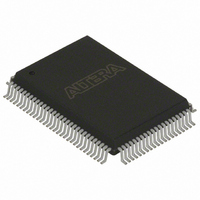EPC4QC100N Altera, EPC4QC100N Datasheet - Page 7

EPC4QC100N
Manufacturer Part Number
EPC4QC100N
Description
IC CONFIG DEVICE 4MBIT 100-PQFP
Manufacturer
Altera
Series
EPCr
Specifications of EPC4QC100N
Programmable Type
In System Programmable
Memory Size
4Mb
Voltage - Supply
3 V ~ 3.6 V
Operating Temperature
0°C ~ 70°C
Package / Case
100-MQFP, 100-PQFP
Memory Type
Flash
Clock Frequency
66.7MHz
Supply Voltage Range
3V To 3.6V
Memory Case Style
QFP
No. Of Pins
100
Operating Temperature Range
0°C To +70°C
Access Time
90ns
Rohs Compliant
Yes
Lead Free Status / RoHS Status
Lead free / RoHS Compliant
Other names
544-1378
EPC4QC100N
EPC4QC100N
Available stocks
Company
Part Number
Manufacturer
Quantity
Price
Company:
Part Number:
EPC4QC100N
Manufacturer:
ALTERA
Quantity:
25
Company:
Part Number:
EPC4QC100N
Manufacturer:
Altera
Quantity:
135
Company:
Part Number:
EPC4QC100N
Manufacturer:
ALTERA32EOL
Quantity:
135
Chapter 1: Enhanced Configuration Devices (EPC4, EPC8, and EPC16) Data Sheet
Functional Description
June 2011 Altera Corporation
FPGA Configuration
1
The enhanced configuration device features multiple configuration schemes. In
addition to supporting the traditional passive serial (PS) configuration scheme for a
single device or a serial device chain, the enhanced configuration device features
concurrent configuration and parallel configuration. With the concurrent
configuration scheme, up to eight PS device chains can be configured simultaneously.
In the FPP configuration scheme, 8-bits of data are clocked into the FPGA each cycle.
These schemes offer significantly reduced configuration times over traditional
schemes.
Furthermore, the enhanced configuration device features a dynamic configuration or
page mode feature. This feature allows you to dynamically reconfigure all the FPGAs
in your system with new images stored in the configuration memory. Up to eight
different system configurations or pages can be stored in memory and selected using
the PGM[2..0] pins. Your system can be dynamically reconfigured by selecting one of
the eight pages and initiating a reconfiguration cycle.
This page mode feature combined with the external flash interface allows remote and
local updates of system configuration data. The enhanced configuration devices are
compatible with the Stratix Remote System Configuration feature.
For more information about Stratix Remote System Configuration, refer to the
System Configuration with Stratix & Stratix GX Devices
Handbook.
Other user programmable features include:
■
■
■
■
FPGA configuration is managed by the configuration controller chip. This process
includes reading configuration data from the flash memory, decompressing it if
necessary, transmitting configuration data via the appropriate DATA[] pins, and
handling error conditions.
After POR, the controller determines the user-defined configuration options by
reading its option bits from the flash memory. These options include the configuration
scheme, configuration clock speed, decompression, and configuration page settings.
The option bits are stored at flash address location 0x8000 (word address) and occupy
512-bits or 32-words of memory. These options bits are read using the internal flash
interface and the default 10 MHz internal oscillator.
After obtaining the configuration settings, the configuration controller chip checks if
the FPGA is ready to accept configuration data by monitoring the nSTATUS and
CONF_DONE lines. When the FPGA is ready (nSTATUS is high and CONF_DONE is low), the
controller begins data transfer using the DCLK and DATA[] output pins. The controller
selects the configuration page to be transmitted to the FPGA by sampling its
PGM[2..0] pins after POR or reset.
Real-time decompression of configuration data
Programmable configuration clock (DCLK)
Flash ISP
Programmable power-on-reset delay (PORSEL)
chapter in the Stratix Device
Volume 2: Configuration Handbook
Remote
1–7














